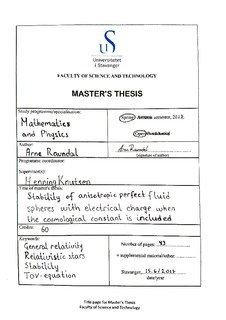| dc.description.abstract | The main task of this thesis is to investigate the stability of anisotropic perfect fluid spheres with electrical charge when the cosmological constant is included. However, before we get so far we needed to read articles about the subject. We have read articles about the stability of anisotropic fluid spheres with and without charge, we have read articles about the stability of isotropic fluid spheres with and without cosmological constant, but one of the reasons we’ve taken on this thesis, is that we could not find any articles covering the stability of all of these things at the same time.
It was Chandrasekhar who was the first to develop this pulsation equation in his work from 1964 [1], for an isotropic, uncharged perfect fluid sphere. In 1979 Irving Glazer [2] developed the same pulsation equation for an isotropic charged fluid sphere. These pulsation equations have been showed to be trustworthy, so any pulsation equation we reach for the anisotropic charged perfect fluid sphere with the cosmological constant included should match these equations for the isotropic charged and uncharged case, without the cosmological constant.
While reading different articles [4] we stumbled over an article written by M.Esculpi and E.Aloma [3] regarding charged anisotropic fluid spheres. In this article most of the calculations are left out, which is not necessarily a problem in itself, but they state that they use the conservation of the energy-momentum tensor, they site the calculations of the required perturbed quantities, and simply gives the end result, which is a fairly long pulsation equation. The problem, however, is that in the few equations given there are several mistakes. They could very well be simple typos, but we wanted to make sure that the end result was trustworthy. Since no calculations were shown, we had to reproduce them and see whether we reach the same result.
After that we shall develop the pulsation equation for an anisotropic charged fluid sphere when the cosmological constant is included. This is an equation that, to our knowledge, has not been developed. The last section in this thesis will be dedicated to develop the Tolman-Oppenheimer-Volkoff equation to go with the pulsation equation. | nb_NO |

